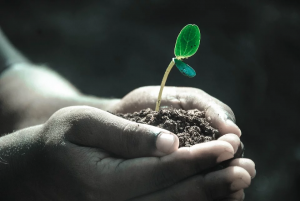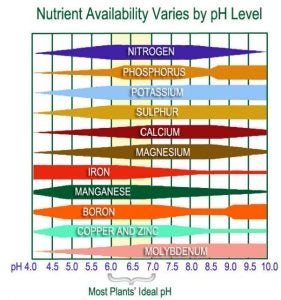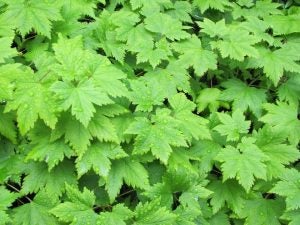Preparing the soil is the be-all-and-end-all when it comes to producing healthy crop yields. You can take steps to improve your soil health at any time of year, but the end of the growing season is a particularly good time to get things ready for spring sowing.
When thinking about preparing your fields to plant spring and summer crops, it’s a good idea to consider your desired end results and think about how you’ll produce a healthy crop free of toxins and full of nutrients.
Soil health is divided into three subsections: physical, biological and chemical.
Physical Structure: The physical structure of the soil is composed of four materials: clay, sand, silt, and loam, which are present in every soil. The proportion of each material determines how well the soil will retain water and nutrients and how the particles within the soil bind to each other.
Biological: The number, as well as the diversity of the species present within the soil, are critical to overall underground health.
Chemicals: The amount of different minerals and how they balance each other out is a massive factor in the health of the soil and ultimately, the final crop.
All three of these factors are essential when viewed in isolation; however, the soil’s health improves considerably when all three of these come together in perfect balance.
This article explores how to achieve the right soil to produce better crop yields.

Why Is Quality Soil Important?
Soil is far more than dirt and rocks — it’s full of nutritious minerals, diverse microbes, and all the things that plants need to not only survive but to thrive.
Everything you plant will require certain nutrients to continue to grow. However, some soil may need a bit of a push in the right direction — particularly if you’ve had a tough growing season.
You should keep the following in mind when improving soil health:
Soil Test: Before you do anything to your land, it’s a good idea to discover what might already be in the ground by undertaking a soil test.
Your Soil pH is Important: Your soil pH is an important metric, when you’re trying to achieve the right conditions for your crop, or when deciding what new crops you could grow on your fields.
Knowing whether the land is acidic, alkaline or neutral will give you valuable insight when you’re looking to tailor your fertilizers, so you don’t overload or starve the land of a particular mineral.
Soil pH also impacts the level of nutrients and minerals within the soil, as well as how well a plant can gather and process them. For example, a pH that is too low or too high could result in nutrient deficient, toxic plants.
Ideal Soil pH: The pH scale goes from 0 to 14, with 7 being “neutral,” 0 being “very acidic,” and 14 “extremely alkaline,” otherwise known as “basic.” Generally, any normal soils will sit somewhere between 6 and 7.5. However, a pH range between 6 and 7 is ideal because this stimulates microbial activity and allows roots to access the most nutrients.

Adjust Soil pH: If you’ve tested your soil, you might discover that your pH balance isn’t within the right area that you need it to be, and in this case you’ll need to begin work to make soil amendments, to raise or lower the pH balance.
- To raise soil pH, you’ll need to distribute lime or wood ash
- To lower soil pH, you should add sulphur, peat, or organic material
Nitrogen, Phosphorus and Potassium
Plants require three primary nutrients:
- Nitrogen: Nitrogen promotes strong stem and leaf production, which is desired in broccoli, cabbage, green veg and herbs.
- Phosphorus: Phosphorus encourages early root and plant development in fruits, blossoms and seed formations, which are important for peppers, squash, tomatoes and cucumbers.
- Potassium: Potassium promotes plant root durability, stress and disease resistance while enhancing the flavor of the crop, which is important for carrots, radishes, onions and garlic.
It’s important to avoid applying fertilizers in excess, as they can damage root systems and deplete other minerals and elements your plants might require. Choose your fertilizers very carefully, and consider cover crops to help encourage worms and microbes.

What Cover Crops Should I Plant?
After your primary growing season, the grounds ecosystem is still thriving, and the more you can do to keep the soil diverse and vibrant, the healthier your crops will be.
Cover crops can be planted in your fields and grown for a relatively short period to support beneficial wildlife, suppress weeds and improve the health of the soil.
The cover crop will then be harvested and worked back into the soil to feed it before crops are planted.
Heavy soils would benefit from the growth of cereal rye, which helps to break down and improve soil structure with their long fibrous roots.
Mustard is a particular favorite since it grows very quickly and can be reintroduced back into the soil to improve organic content.
Legume crops help to restore nitrogen into the soil, such as winter field beans and peas, clover and vetch.
Buckwheat is also another beneficial choice, since it’s a fantastic weed suppressant and will attract bees and insects in spring.
Drainage and Soil Structure
The structure and texture of your soil will play a significant role in the success of your final crop. Soil that retains too much moisture can encourage fungal growth, and lead to infections such as root rot. Conversely, soil that is incapable of holding much water can lead to malnourished, dehydrated plants.
Most soil will lean towards one of four categories: silt, sand, clay or loam (which contains a balance of sand, silt and clay) and each has its own characteristics.
- Sandy Soil: Sandy soil contains large particles and will drain moisture quickly. Sandy soil won’t hold its nutrients very well but does trap warmth in the spring. Root crops, such as onions and asparagus, grow well in sandy soils.
- Silt Soil: Silt soils contain smaller particles, which give them an almost powdery, floury texture. Silt soil retains moisture and nutrients far better than sandy soil. Brassicas such as cabbages tend to grow well in this kind of soil.
- Clay Soil: Clay soils are made up of very fine particles. Clay soil is firm, which means it’s slow to draw moisture and drain; creating hard ground in summer and waterlogged surfaces in winter. Clay soils are the preferred soil of beans, peas and salad crops.
- Loam Soil: Loam soil is ideal for growing a range of fruits and vegetables. It’s fertile, drains quickly and is easy to work with due to its high concentration of organic matter, which will support just about any crop.
Conclusion
Spring is a busy period for farmers and landowners. Once the weather warms and the cold thaws, it’s essential for the planting to begin.
This is why winter is such a critical time since farmers need to be proactive to prepare the land for whatever crop they are hoping to grow throughout the warmer months.
David Whattoff is a farming and agricultural expert and the managing director of METOS UK, a smart tech company specialising in field, climate and weather monitoring systems.



